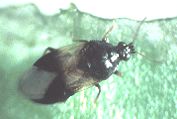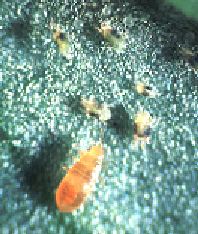

II. Hosts: Minute pirate bugs may be found on a number of important crops including most deciduous fruits, corn, cotton, soybeans, alfalfa and grapes. The primary sources of food are aphids, phytophagous mites, insect eggs, and soft bodied insects. This predator can feed on plants and pollen although complete reliance on these sources of food may have a detrimental effect on reproductive potential.
III. Description: Minute pirate bug adult males are slightly smaller than females but both are around 1/10 inch (2 mm) in length. Superficially the two sexes appear very similar. The head and thorax are shiny and black, and the beak extends to between the base of the first pair of legs. The second antennal segment is pale yellow but the others are brownish. The forewing has a small dark area at the base followed by a wide light yellowish brown area (appears white to casual viewer) and then a triangular, smaller, dark (brownish-black) area (left picture above). The remainder of the forewing is membranous and pale, appearing white from a distance. Eggs are approximately 2/100 inch in length and 3/1000 inch diameter (0.5 mm X 0.1 mm). The elongate, clear eggs become milky white as they develop and the red eyes of the embryo show through the shell before hatching takes place. The eggs are embedded in plant tissues with the operculum exposed when they are laid. Incubation for about 5.8 days at 73°F (22.8°C) is required for hatching to occur. Nymphs, like those of other true bugs pass through five instars before becoming adult. Approximately 19 days are required to complete the nymphal stages and with each molt the young more closely resemble the adults they will become. However, in the nymphal stages (right picture above) genitalia and wings are rudimentary and non-functional. When they first hatch nymphs are almost clear in color but do have a slight yellowish tinge. However, as they mature they become progressively darker until in the fifth instar they are almost mahogany. Total length of nymphs ranges from 1/100 inch (0.2 mm) (first instar) to 2/100 inch (0.48 mm) (second instar).
IV. Biology: The minute pirate bug overwinters as an adult in leaf litter both inside and outside the orchard. They normally appear in Virginia orchards about mid-April and begin to feed on aphids, mites, or other soft-bodied insects or eggs. The predator remains active in orchards through October and thus exerts a predatory influence throughout the entire season. The minute pirate bug possesses an efficient searching behavior and is a voracious general feeder. It is able to aggregate in areas of high prey density and increases its numbers more rapidly in such situations where there is an abundance of prey. This predator does feed occasionally on other predators but this is not a serious problem with the insect in its role in pest management programs. Minute pirate bugs may also occasionally fall prey to general predators such as spiders and lacewing larvae.
V. Injury: This predator does not injure
crop
plants to any significant degree. There are occasions when the adults
will
attempt to penetrate human skin with their proboscis causing a mild
stinging
sensation. Such instances are unusual and not severe.